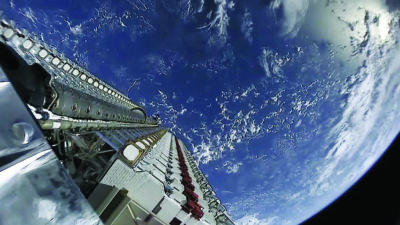Stay Up to Date
Submit your email address to receive the latest industry and Aerospace America news.
The Communications Systems Technical Committee is working to advance communications systems research and applications.
Satellite operators curtailed geosynchronous satellite orders in 2019 for a fifth consecutive year, a trend driven by overcapacity and falling prices in many markets, ongoing advances in and additions to planned non-geosynchronous orbit megaconstellations, and persistent market uncertainties. The specter of 50,000 NGSO broadband smallsats (satellites with mass less than 1,000 kilograms) planned for launch over the next decade — promising even greater capacity — further motivated GSO operators to delay or cautiously restrict additional investments in their fleets. This, in turn, led to the restructuring of GSO satellite manufacturing stalwarts, including Maxar Technologies (formerly SSL) and Thales Alenia Space. The downturn also prompted the acquisition of AsiaSat, Avanti and Inmarsat by private equity interests; other operators, including APT Satellite and Sky Perfect JSAT, examined alternative business models.

In March, Northern Sky Research reported that capacity prices declined 18% over the preceding year, extending declines of 35% to 60% incurred over the prior two years. The price declines were once again attributed, in part, to additional high-throughput satellite launches. Exacerbating these challenging market conditions, advances in planned NGSO broadband megaconstellations were seen throughout the year. In February, OneWeb launched the first six of its 648 smallsat constellation, while in May, SpaceX launched the first 60 of its ultimately 42,000 smallsat Starlink constellation and another 60 in November. Further increasing prospective capacity, Amazon’s Kuiper Systems in July filed an application for FCC approval of its 3,236 satellite NGSO constellation comprised of 784, 1,296 and 1,156 smallsats at 590-kilometer, 610 km and 630 km orbital altitudes, respectively.
Against this backdrop, unsurprisingly, only seven competitive, commercial GSO orders were recorded as of the end of October, suggesting a year-end total of eight orders — an extension of the depressed orders trend that began in 2015. Commercial GSO satellite orders totaled 19, 15, eight and five in 2015, 2016, 2017 and 2018, respectively, after averaging 26 per year during the three years prior. Six additional GSO orders were received for military applications, some from commercial operators, suggesting a convergence of the commercial and military markets.
In response, the industry increased its focus on an emerging class of small broadband communications satellites, or “micro-GSO satellites,” designed to fill capacity gaps too small to justify the time, expense and risk of deploying a traditional 4- to 8-metric-ton GSO communications satellite. Development of these 250 kg to 2,000 kg micro-GSO satellites was ramped up by startups Astranis, GapSat, Saturn Satellite Networks and the SWISSto12-Tyvak partnership and by established manufacturers including Maxar (which received an Ovzon-3 order) and Boeing. This trend partially offset the decline in conventional GSO orders.
In August, Northern Sky Research reported that at least 16 companies, including Astrocast, Fleet, Kepler, Lacuna Space, Myriota and Sky and Space Global, were developing NGSO constellations of between 32 and 200 cubesats (the body dimensions of which are low multiples of 10-centimeter cubes) to provide “internet of things” communications services in remote markets. Although the revenue from these activities represents a small fraction of recent GSO market sales declines, the initiatives nonetheless demonstrate the industry’s willingness to innovate to cost-effectively address emerging opportunities.
Supporting this innovation, the launch vehicle industry, led by SpaceX and smallsat launch vehicle developer Rocket Lab of California, continued to drive costs lower, reducing the expense of installing additional communications satellite capacity. As of mid-November, SpaceX had conducted nine Falcon 9 and two Falcon Heavy launches in which booster stages were routinely recovered. Rocket Lab conducted five Electron smallsat launches in this timeframe and, perhaps encouraged by SpaceX’s success, announced in August that it was developing a reusable booster. During this pivotal month, SpaceX revamped its smallsat ride-share program, lowering launch costs to $5,000 per kilogram, about 20% of the rate that had prevailed for decades. Inasmuch as estimates indicate as many as 100 smallsat launch vehicles are under development worldwide, the costs of space access and providing additional communications satellite capacity will undoubtedly continue to decline.
Contributors: Chris Hoeber and Roger Rusch
Related Posts
Stay Up to Date
Submit your email address to receive the latest industry and Aerospace America news.




